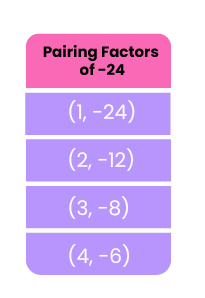Embark on an intriguing mathematical journey as we delve into the fascinating world of the number -24. This exploration will reveal the underlying structure of -24 through its factors.
Our goal is to demystify the factors of -24, revealing the numbers that combine through multiplication to arrive at -24.
What Are the Factors of -24?
The factors of -24 are the numbers that, when paired and multiplied, equal -24. These factors offer a glimpse into the structure and composition of -24. Typical factor pairs include:
1 and -24, 2 and -12, 3 and -8 and 4 and -6.
Pair Factors of -24
The number -24 pair factors are sets of two numbers that result in -24 when multiplied together. This concept extends to both positive and negative pairs, as the multiplication of two negatives also yields a positive result.
Positive and Negative Pair Factors of -24:
How to Find the Factors of -24?
To find the factors of -24, follow these simple steps:
1. Starting Point:
Pair -1 with 24 and 1 with -24, as multiplying by 1 or -1 maintains the number’s value or switches its sign.
2. Checking for Divisibility:
Look for numbers that divide -24 evenly—for instance, -2 pairs with 12 and -3 pairs with 8.
3. Considering Square Roots:
Investigate numbers up to the square root of 24 for possible factors, remembering their negative counterparts.
4. Incorporating Negative Factors:
Remember to include negative factors, as they play a crucial role in achieving -24 when multiplied with their positive equivalents.
Thus, the factors of -24 include a mix of positive and negative numbers:
-1, -2, -3, -4, -6, -8, -12, -24, and their positive equivalents.
Prime Factorization Method
Prime factorization involves deconstructing a composite number to its prime components, the fundamental prime numbers that, when multiplied, reconstruct the original number.
The prime factorization process breaks down a number into its prime factors. For -24, the process unfolds as follows:
1. Initial Step:
Begin with the smallest prime number dividing 24, which is 2.
2. Progressive Division:
Divide 24 by 2 to get 12, then continue with the following smallest prime number, and so on, until only prime numbers are left.
3. Identifying Prime Factors:
The prime factorization of 24 is 2³×3. For -24, this translates to -2³×3.
Summary
This in-depth exploration offers a comprehensive understanding of the factors of -24, emphasizing pairs such as -1 and 24, -2 and 12, and their positive counterparts. Understanding these factors, including their prime factorization as -2³×3, is crucial for anyone interested in the elegance and intricacies of mathematics.
They not only deepen your mathematical understanding but also sharpen your problem-solving skills. Whether you’re in the classroom or facing real-world mathematical challenges, mastering these methods will undoubtedly prove beneficial.
Frequently Asked Questions on Factors of -24
Q1: What are the factors of -24?
Ans: The factors of -24 include both positive and negative numbers that, when paired and multiplied, result in -24. These are -1, -2, -3, -4, -6, -8, -12, -24, and their positive counterparts.
Q2: How can I identify the factors of -24?
Ans: To find the factors of -24, start with 1 and -1 and examine which numbers evenly divide -24 without leaving a remainder.
Q3: Does -24 have both positive and negative factors?
Ans: Yes, -24 has both positive and negative factors, each playing a role in achieving the product of -24.
Q4: What is the prime factorization of -24?
Ans: The prime factorization of -24 is -2³×3, reflecting the negative version of the prime factorization of 24.
Q5: Are the factors of -24 relevant in practical situations?
Ans: Understanding the factors of -24 can be helpful in various real-world scenarios, such as solving mathematical puzzles or in contexts involving negative numbers and their interactions.
Moonpreneur understands the needs and demands this rapidly changing technological world is bringing with it for our kids. Our expert-designed Advanced Math course and Math Quiz for grades 3rd, 4th, 5th, and 6th will help your child develop math skills with hands-on lessons, excite them to learn, and help them build real-life applications.
Register for a free 60-minute Advanced Math Workshop today!


















